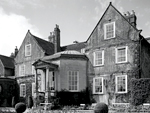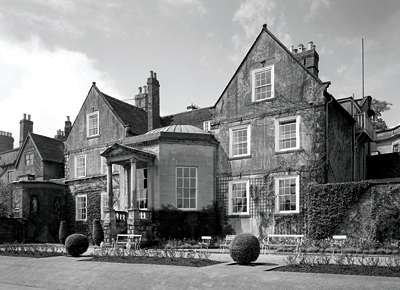Two country house gems in need of restoration
Two fantastic, historic, country houses are in need of a saviour to restore them to their former glory


The medieval market town of Ashbourne, Derbyshire, sits in a deep, well-wooded valley on the edge of Dovedale, gateway to the Peaks. It had its heyday in the 18th century when its location at the junction of six main coaching roads brought visitors to the area from all over England. Reflecting the town's standing as a centre of fashionable and intellectual life, many of its domestic buildings were rebuilt in brick around that time and its centre lined with large impressive Georgian houses.
One of the grandest was the Jacobean Mansion House built by Ashbourne attorney Benjamin Taylor in 1683-84, and altered and extended in the mid to late 1700s by his grandson, the Rev John Taylor, a lifelong friend of diarist Samuel Johnson. The striking, 8,988sq ft Mansion House, listed Grade I, was a boarding house for a local girls' school when it was bought in the 1990s by its present owner, who has secured the basic fabric of the building, but has been prevented by ill-health from completing the restoration. As a result, this rare and important town house will be offered for sale at auction on July 8, 2010, at a guide price of £550,000 through Knight Frank (0121-362 7878), if not sold privately beforehand.
An article in Country Life (March 28, 1968) traces the evolution of the Mansion House against the background of the longstanding friendship between Doctors Johnson and Taylor, which began with their days at Lichfield grammar school in the early 1720s and ended with Johnson's death in 1784. On the face of it, the two had little in common: Johnson was an intellectual and a man of letters and Taylor a ‘squarson', described by Boswell as ‘a hearty English squire, with the parson super-induced', who bred cattle, horses and bulldogs. Yet, year after year, Johnson went to stay with Taylor at Ashbourne, despite being often bored and abandoned when Taylor disappeared to his farm.
Having inherited a sizeable fortune as well as a fine house on his father's death, while he and Johnson were still studying at Oxford, Dr Taylor opted for a career in the church instead of the law. With no offspring or wife to support (his second wife having left him in 1763), Taylor lived alone in great style. From the 1760s onwards, he had his grandfather's house altered, re-fronted and improved, with the addition of the splendid, 24ft round by 24ft high, octagon drawing room with its magnificent ceiling overlooking the garden to the rear of the house. Its design is attributed to either Robert Adam or James Paine, and was probably executed by Derby architect James Pickford. The grand entrance hall, with its ceiling medallion representing The Rape of Ganymede by Antonio Zucchi, was added some 20 years later, and may have been the work of Thomas Gardner.

The panelled dining room remained unaltered apart from the Georgian addition of the pine panelling framed in oak and an 18th-century marble fireplace. The morning room opposite, with its shuttered windows and possible courtyard access, also has a fine open fireplace. There are four bedrooms and a washroom on the first floor, and a further six bedrooms and two bathrooms on the second floor. In Dr Johnson's day, the garden of the Mansion extended southwards, well beyond its present boundary, the Henmore Brook, which Taylor had dammed to form a small lake and a waterfall. Meanwhile, still standing on the east side of the garden is the pretty, Grade II*-listed, small stone temple, still known as ‘Dr Johnson's summer house'.
The Rev Taylor died in 1788, and, from the mid-1850s onwards, the Mansion House was sold a number of times before falling into disrepair. In the early 20th century, it was eventually bought by a Dr Sadler who renovated the dilapidated building and restored the gardens, living there until his death in 1945. In 1950, the Mansion House was bought by the Derbyshire Education Committee as a residence for the headmaster of the grammar school, the old buildings of which face it from across the road.
The sale of the Mansion House provides an opportunity to re-create a Georgian gem, but that of The Grange at Little Plumstead, five miles east of Norwich offers the chance to revive a Victorian Gothic masterpiece around a historic Tudor core. Savills (01603 229229) quote a guide price of £1.3 million for the picturesque, Grade II*-listed country house set in some 12 acres of totally private gardens and grounds overlooking its own lake. For 38 years, The Grange has been the much-loved family home of art historian Phyllis Oates and her late husband, the oil painter Bennett Oates, renowned for his classic flower studies and striking Impressionistic landscapes, who died in March last year. A single-minded artist who became the first president of the Guild of Norwich Painters in 1998, his flamboyant presence can still be felt around the Grange, which was a very different place when they bought it at auction in 1972, Mrs Oates recalls.
Exquisite houses, the beauty of Nature, and how to get the most from your life, straight to your inbox.
The previous owner had been a Mr Hill, a wealthy manufacturer from Stoke-on-Trent, who bought the house for his mistress and later moved there himself when his wife discovered their liaison and promptly left him. The lady of the house died shortly afterwards, whereupon Hill became something of a recluse, gradually retreating to one room on the ground floor, where he chain-smoked his remaining days away.
One by one, Mr and Mrs Oates reclaimed the charming Victorian Gothic rooms-from the pretty entrance and staircase halls, to the dining room on one side of the hall and, on the other, the interlinked drawing room, morning room and study, and Mr Oates' beloved billiard room beyond. They added a Victorian-style conservatory to the rear of the house, and refurbished the six bedrooms and two bathrooms upstairs. This is a house of charm and authenticity, which has Mrs Oates' gentle touch, but, after almost 40 years, it now needs general refreshment and updating. For a modern family, this might include converting the billiard room into a large kitchen/living area overlooking the garden.
The Grange's origins are no less intriguing, its 16th-century origins evident in its fine Tudor brickwork and polygonal buttresses. Known then as Plumstead Hall, it was the seat of the Hobarts and the birthplace, in 1563, of Sir Henry Hobart, who bought the Manor of Blickling in 1616. Blickling Hall was completed in 1621, at which point Sir Henry left the hall, which then became a hunting lodge and was probably reduced to its present size at that point.
In 1806, Plumstead Hall was remodelled by Norwich architect Arthur Browne for Francis Gostling in the Gothick style made fashionable by Horace Walpole at Strawberry Hill in the late 18th century. The picturesque landscaped gardens and lake would also have been laid out at about this time. Commenting on the sale of this ‘estate in miniature', with its walled garden, orchards, coach house and stables, Louis de Soissons of Savills adds: ‘It's rare indeed to find an architectural gem such as The Grange in totally unspoilt surroundings so close to a cathedral city. It would probably take a budget of £300,000-£500,000 to upgrade the house and grounds to today's standards, but you would then be looking at a house worth £2m or more.'
* For more properties like this every week, subscribe and save
Country Life is unlike any other magazine: the only glossy weekly on the newsstand and the only magazine that has been guest-edited by His Majesty The King not once, but twice. It is a celebration of modern rural life and all its diverse joys and pleasures — that was first published in Queen Victoria's Diamond Jubilee year. Our eclectic mixture of witty and informative content — from the most up-to-date property news and commentary and a coveted glimpse inside some of the UK's best houses and gardens, to gardening, the arts and interior design, written by experts in their field — still cannot be found in print or online, anywhere else.

